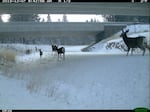
Deer at wildlife crossing.
Oregon Department Of Transportation / Oregon Department Of Transportation
The Southern Oregon Wildlife Crossing Coalition is hoping to conduct a feasibility study to determine the best locations to build bridges or tunnels for wildlife crossings.
“Depending on the types of species that you’re trying to get across the road, these can be as complex as a large, naturally planted bridge, or as simple as a small steel or concrete culvert going under the road,” says Rachel Wheat with the Oregon Department of Fish and Wildlife.
She says while drivers kill animals regularly, roadways like I-5 disrupt the ecosystem in bigger ways.
“These transportation corridors fragment wildlife habitat and makes them difficult to access the places that they need to fulfill their basic life history” Wheat says. “To access food and shelter and opportunities to reproduce and raise young.”
There are many places in Southern Oregon between Ashland and the California border where there are increased animal-vehicle collisions.
“We are looking at seven sites,” says Amy Amrhein, the volunteer coordinator with the Southern Oregon Wildlife Crossing Coalition. “They don’t all have to be big. Some of them can be small. Neil Creek is a fish passage. So again, there are all kinds of different animals that we are looking at and want to help cross.”
The creation of wildlife crossings is dependent on the passage of HB 4130 by the Oregon Legislature. The bill would allocate $7 million to wildlife-friendly infrastructure projects.